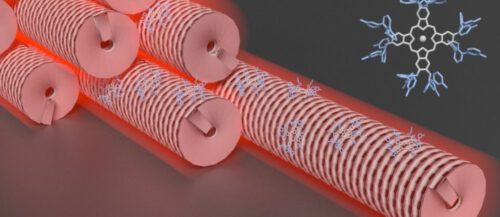Updated research shows that viruses can be used as structural scaffolds to immobilize photoactive molecules designed to oxidize organic pollutants present in waste water after exposure to visible light
[Translation by Dr. Moshe Nachmani]

A research team from Aalto University was able to develop an innovative approach to create virus-based materials used as catalysts. The purpose of the project is to pave the way for the application of optically active biohybrid materials - a combination of biomolecules with synthetic materials - in a variety of fields ranging from nanomedicine to 'green' organic synthesis or environmental science. "Our first challenge was to choose the right photo-emotion," says the lead researcher. "We decided to use substances from the phthalocyanine family, which is a synthetic derivative of hematoporphyrin (Hematoporphyrin, the pigment responsible for the red color of blood), thanks to their extraordinary properties as substances that generate active oxygen species. However, the use of such type of dyes in an aqueous solution presents several challenges that affect their performance. Therefore, careful planning was necessary in order to preserve their properties.
The researchers succeeded in synthesizing a new derivative of phthalocyanine, obtaining a molecule with stable properties in solutions with different ionic strength. The design of the particular derivative ensured that the optical activity of the dye would be maintained even in aqueous environments. "One of our group's research areas is related to the design of new protein structures and their potential application as new materials," adds the researcher. "Our approach is based on interactions of supermolecules, such as electrostatic chemical bonds, when we decided to combine the positively charged dye material together with the negatively charged virus (tobacco mosaic virus), while obtaining an optically active fibrous material. This approach gave rise to highly ordered filaments that were characterized structurally and chemically by X-ray scattering and by several microscopic methods. In addition to the structural characterization, the researcher emphasizes that the most essential component of this dye remains active even though it is incorporated and anchored within the fibers. "We are able to determine the reaction site within a solid substrate and transfer the solution we wish to react with the dye, when visible light is the only 'fuel' we use for this purpose. This approach allows us to create a flow system that can be streamlined (increasing the quantities and equipment in process development in the transition from laboratory production to industrial production) of the oxidation process," explains the researcher.
The research team was able to produce a 'proof of feasibility' type device while anchoring these fibers inside a glass tube when the incoming current undergoes oxidation in several cycles. The researchers measured the stability of the fibers and concluded that both their structural stability and optical activity remained constant over time. Another advantage inherent in the system is that once the oxidation process is complete, a beam of light can break down the fibers and thereby facilitate their disposal in the trash. The approach reported in this study is the first step towards the use of bio-hybrids in continuous flow reactions, an approach that presents an environmentally friendly approach to this type of industrial process.
For information on the university website
More of the topic in Hayadan:
